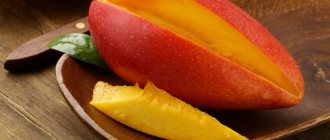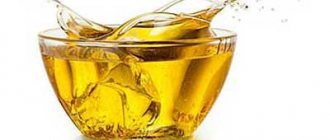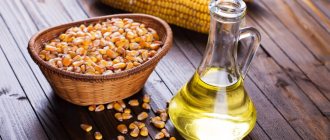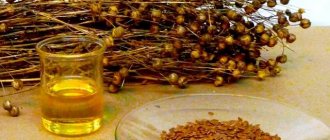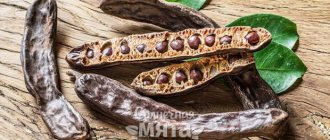Composition and calorie content of butter
The amount of proteins, fats, carbohydrates and calorie content of butter per 100 g is presented in the table:
| Characteristic | Value per 100 g |
| Squirrels | 0.5 g |
| Fats | 82.5 g |
| Carbohydrates | 0.8 g |
| Calories | 748 kcal |
The product contains B vitamins, retinol (vitamin A), tocopherol (vitamin E), nicotinic acid (vitamin PP) and vitamin D. Most of these elements are fat-soluble.
How to choose a good one: determine the quality when purchasing, can you check it at home?
When purchasing in a store, find the GOST number on the packaging.
A genuine product corresponds to the composition of only three quality marks of butter according to GOST:
- R 52 969-2008;
- R 32261-2013;
- a Vologda delicacy with a sweetish, nutty flavor should be assigned the GOST number R 52 253-2004.
REFERENCE ! Margarine has GOST R 52178-2003.
Preference should be given to packs in foil rather than paper or parchment. The quality deteriorates noticeably when exposed to direct light.
What does butter contain? The product can also be manufactured according to specifications. It is necessary to study the composition on the packaging. In this version of butter, the composition should only contain cream (milk) and salt (in a small amount) . If you see “vegetable fat,” this means that this is a spread or margarine.
The quality of butter can be assessed by buying it on the market, simply by tasting the product. It should melt quickly in the mouth (melting point - 32-35 degrees) and have a pleasant aftertaste. If the mass sticks on the tongue, has a taste of margarine, leaves a bitter or simply unpleasant aftertaste, then you should resolutely refuse to purchase it.
Another indicator of the quality of butter is the color of the product.
The oil should be pale yellow or white, with a creamy tint. Pure white color corresponds to margarine, and yellow indicates the presence of dyes in the product.
At home, you can check the quality of butter like this:
- Freeze and thaw at room temperature . All fakes become soft after half an hour and become covered with droplets of water. Natural products remain hard for three hours or more. There are no drops of water on the surface.
- Melt a small amount over low heat . This product will begin to separate as it heats up. The margarine and spread will remain homogeneous, releasing a characteristic smell with a petrochemical tint.
- Place a small piece in hot water . The butter will melt evenly. The fake will melt much more slowly, breaking up into separate parts.
Also, when purchasing, look at the permissible sales period. On packs it is indicated on the packaging. If you buy it by weight, you can ask the seller for a certificate for a batch of product or a certificate.
This video contains some more tips on how to determine the quality of butter:
Useful properties of butter
The product contains useful substances that have a beneficial effect on the human body:
- Cholesterol. Takes part in strengthening the walls of blood vessels, promotes the production of acids and various hormones.
- The presence of retinol in the product normalizes the functioning of the gastrointestinal tract, helps with colds and diseases of the bronchi and lungs.
- The presence of various fatty acids helps saturate the human body with energy.
- A large amount of fat promotes the renewal of human adipose tissue cells. This is especially important for nerve tissue and the brain.
For women
An insufficient amount of cholesterol leads to the fact that some hormones are not produced in the fair sex. Because of this, women cannot get pregnant and their periods disappear.
For men
For men, refusing to consume a healthy product will lead to a decrease in sexual activity. There will also be difficulties in conceiving.
Is it possible to use butter during pregnancy and breastfeeding?
If the expectant mother wants this product, then you should not deny yourself the pleasure. It is allowed for pregnant women, and here's why:
- high calcium content, which affects the skeletal system;
- the presence of macro- and microelements that strengthen the immune system, control the functioning of the digestive system, improve vision, skin and hair;
- caloric content and saturation of the body with energy;
- reduces fatigue.
When breastfeeding a newborn, the use of the product is recommended. The benefits of butter for children are quite extensive.
Reference! You need to purchase only high-quality natural products, then they will benefit the nursing mother.
It is made from natural milk, and when breastfeeding, milk and any dairy products are simply necessary.
However, when breastfeeding, this product should be introduced gradually. It's better to add it to porridge.
Is butter good for weight loss?
To talk about the health benefits and harms of butter, we need to consider each position separately.
Benefits of butter on a diet:
- an insufficient amount of fat in a girl’s diet leads to appearance problems - hair, skin, nails;
- when losing weight, the participation of animal fats is necessary, since the skin is regularly tightened following a decrease in body volume due to weight loss;
- the presence of vitamins and minerals that help strengthen the immune system, control digestion, strengthen bones and blood vessels, are also required by the body when a girl is on a debilitating diet.
Harm:
- the high fat content in the product, subject to regular consumption in large quantities, leads to the fact that fat is not burned as it should be, but accumulates;
- the presence of cholesterol, despite the benefits of this element, in large quantities it leads to blockage of blood vessels.
The use of this product when losing weight is not only possible, but also recommended, but the benefits of butter for the human body are only in moderate quantities. Otherwise it will cause harm.
Summarize
Natural butter, obtained from the milk of grass-fed cows, is actually an amazing, healthy product that has a significant number of beneficial properties.
The term “healthy butter” is especially true when you are purchasing an organic product. This oil has anti-inflammatory properties, it is good for the cardiovascular system, helps increase energy production in the body and reduces appetite.
Of course, you need to buy what you can afford and what you have access to, but if you do have the option, stick to healthy butter options!
Tags: Butter
- Related Posts
- Is canola oil healthy? Everything you need to know
- What is the difference between butter and margarine? Which is healthier?
- Walnut oil: health benefits and harms
« Previous entry
Treatment with butter
The useful product is widely used in folk medicine. With its help you can eliminate symptoms and cure some diseases:
- Sinusitis. To prevent the treatment of this disease from leading to a puncture, it is recommended to place a small piece in one nostril every night. And the next night another. It is important that the product is made from milk yourself.
- Runny nose. For chronic runny nose, it is recommended to use the product in melted form. One course will require 500 g of natural oil. It should be boiled in a saucepan over low heat for 40 minutes. Then strain the resulting mixture through cheesecloth. Pour the drained oil into containers and put them in the refrigerator. Drip heated liquid into your nose 3 times a day.
- Haemorrhoids. Butter for hemorrhoids. To do this, it should be mixed with honey in equal proportions. Allow the resulting mixture to harden. Then inject the substance into the anus until recovery.
- Ingrown nail. Steam the nail, put a piece and bandage it. The next day, steam the nail with soda, then place a cotton swab soaked in oil under the edge of the ingrown nail. Bandage. Such manipulations should be carried out for a week until the nail grows back.
We recommend reading: Baking soda: beneficial properties, uses, how to take
Features of using butter
For an adult and healthy person, it is allowed to consume no more than 30 g of the product per day.
Advice! In the winter season, you can double the portion.
Children under 10 years of age should consume no more than 10 g of oil per day.
And those who suffer from cardiovascular diseases should introduce this product into their diet as carefully as possible. Their daily norm is equal to children’s and is 10 g.
For gastritis and stomach ulcers
For these diseases, the use of the product is recommended. However, you should only consume a low-fat product, 1 teaspoon on an empty stomach. Otherwise, this can lead to an exacerbation of the disease.
Also used with propolis. To do this you need to prepare a mixture. 10 g of propolis are mixed with 100 g of oil. Take 1 teaspoon of this mixture before meals.
For diabetes
For diabetics, eating fatty foods is contraindicated. This includes butter. However, you should not completely exclude the product from the diet, since it has benefits for every organism, but subject to the required dosage.
The correct dosage not only saturates the body, but also has a therapeutic effect. Vitamin A in the product helps strengthen the immune system and helps avoid visual impairment.
For pancreatitis
If the patient has an exacerbation of pancreatitis, then the product should be introduced into the diet no earlier than 2 weeks after the exacerbation. In this case, it should be added to porridge or puree. The daily dose is 3-5 g.
If you feel well and are not tormented by symptoms, the daily dose should be increased to 30 g in 2-3 doses. It is recommended to consume the product by adding it to warm food before meals.
Contraindications and harm
- Contraindicated for use in pancreatitis, especially acute conditions.
- Excessive consumption of butter can harm the body and cause the development of atherosclerosis due to the presence of high cholesterol.
- It is harmful for older people to consume in incorrect proportions (no more than 50 grams per week).
- Contraindicated for regular use in people who are overweight.
- Include in the diet with caution if you have frequent diarrhea or allergic reactions.
The use of butter in cosmetology
This product is widely used in cosmetology. Its advantage lies in the presence of fats, phosphates and mineral components.
The oil is used as a remedy for wrinkles.
Face masks
The benefits of butter for the skin allow you to use it against wrinkles around the eyes. It needs to be applied one and a half hours before bedtime. Before applying, you should cleanse your skin. The product should be applied for 20 minutes. In this case, you need to take a lying position.
Several recipes:
- Cottage cheese. You will need 1 tablespoon of full-fat cottage cheese and the same amount of warm milk. Add ½ teaspoon of honey and a teaspoon of butter. Mix everything thoroughly. Once you have a homogeneous mass, you can apply.
- Banana. For such a mask you will need banana pulp and oil in equal quantities. Stir the mixture until smooth, and then use immediately.
- Potato. Combine three tablespoons of mashed potatoes with 1 teaspoon of butter. This mask is only effective if it is warm.
- Bread Moisten the white bread crumb with melted butter. Squeeze a little and can be applied to the skin around the eyes.
Hair masks
For dull and brittle hair, there are 2 recipes for oil-based masks:
- Recipe 1. Recommended for eliminating dandruff. Combine 100 grams of milk with 1 tablespoon of melted butter. Add a tablespoon of olive oil and a few drops of eucalyptus. It is recommended to rub the resulting mixture into the roots, and distribute the remainder along the entire length of the curls. Then wrap your head in a towel and leave it like that for 30 minutes. Afterwards, rinse your hair with warm water and shampoo.
- Recipe 2. Combine equal amounts of vegetable oil and butter. Then spread the mixture over the entire length and leave for 30 minutes. Then rinse with warm water and shampoo.
What can you fry in oil?
Often men and women wonder whether it is possible to fry in butter. As you know, milk fats are used to make a variety of dishes. And in order for the body to benefit, you need to know a few secrets.
For frying, it is recommended to use genuine oil; do not use margarines or spreads. The product must be melted over low heat so that the healing properties do not disappear. Milk fat produces very flavorful dishes.
The oil is widely used in cooking. You can fry not only scrambled eggs on it, but also vermicelli. You can even prepare a snack if you don’t need significant heat and a lot of time.
Selection rules
The benefits of butter can only be obtained from natural raw materials. Therefore, you need to be able to distinguish a good product from a fake. Carefully study the information on the package and follow the instructions:
- GOST 32261-2013 is written on the packaging.
- The fat content is at least 70%.
- This product is not cheaper than 90 rubles. This is explained by the fact that thirty liters of milk are needed to produce one kilogram of butter.
- If the temperature and relative humidity are observed, the shelf life is 30-35 days.
- If the butter crumbles a lot when cutting, then it contains water.
- Give preference to foil or parchment packaging.
- The name clearly states that this is an oil. Do not purchase with such inscriptions as “Oil for tea”, “Baby oil”, “Dessert oil”.
- The ingredients include whole milk and heavy cream.
- There must be a whole package.
- If the product does not contain vegetable fats, it quickly hardens in the freezer.
How to store
A person's health directly depends on what he eats. You now know about the nuances of the acquisition. Let's talk about how to store butter. The following recommendations are made:
- The optimal temperature for storage is 0-6 degrees.
- Place the oil in an oil dish or a sealable container. This allows you to protect from light and third-party odors.
- It is recommended to store in foil for 21 days, in parchment - 11.
- Do not place on the refrigerator door shelf.
- It is not recommended to wrap in plastic bags.
- For long-term storage, use a freezer with a temperature of -24 to -19 degrees. In such conditions it will last up to 8-9 months.
- Divide into small portions before freezing.
- If a yellow coating has formed on the surface, it must be removed with a knife. This oil is best used for making pies, muffins, and buns.
You can also store the product outside the refrigerator. To do this you will need baking paper, salt and an enamel pan. Cut the butter into pieces and pack in parchment. Place in a saucepan, add a solution of a liter of water and 30 grams of salt. Place in a dark room.
Or wrap it in a cloth soaked in vinegar. This way you can keep it fresh for several weeks. Without preparation, the product can remain in a room for 7 days in the absence of direct sunlight.
Recipes
For variety, you can prepare delicious butter with the addition of other ingredients. Let's look at a few options.
- Oil with dill. Combine 280 g of butter and 45 g of chopped dill. This product does a good job of eliminating flatulence.
- Apple butter. To increase hemoglobin, mix oil, applesauce and bee honey, whisk.
- Butter with herring. Remove the bones from the fish, combine with 2 tbsp. parsley and 390 g butter. The preparation is used for preparing snacks; in addition, it has an anthelmintic effect.
- Lemon oil. Take the juice of one citrus, 250 g of softened butter, 35 g of chopped parsley. It makes an excellent spread for a sandwich and saves you from colds.
The benefits of natural butter are quite high. You can make the product yourself; this will require heavy cream at room temperature. You need to beat for 12 minutes, place in a fine sieve, and leave for a quarter of an hour. If desired, you can add salt to homemade butter; it makes delicious baked goods; you can put it in milk porridges.
Now you know the benefits of butter. If you eat it in acceptable quantities, it will not harm the body. You need to carefully read the information on the packaging when purchasing and follow the storage rules. And if you’re tired of regular breakfast sandwiches, you can add garlic, herbs or fruit to the butter.
How to make homemade butter
Homemade butter has more benefits than store-bought or vegetable butter. To prepare a homemade product, you will only need the fattest unsterilized cream in a volume of 1.2 liters.
Cooking method:
- The cream should be at room temperature. Pour the cream into a container that is 3 times larger than the volume of the cream. Cover the vessel with film. Make several cuts for the whisk forks and start beating at first at slow speed, and then increase to maximum.
- At first the foam will be light, but over time it will become dense and acquire a yellowish tint. The entire procedure will take about 10 minutes. The resulting foam is oil.
- Continue whisking for 2 minutes until the butter separates. As soon as this happens, stop the mixer.
- Drain the contents of the bowl into a colander and leave it like that for a while.
- After 15 minutes, stir the mixture in a colander to drain the remaining liquid.
The oil is ready. You can add salt for taste.


